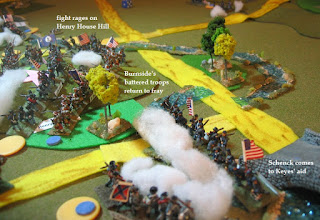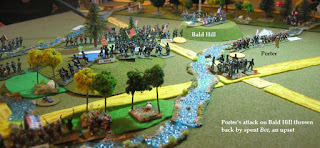Thursday evening we completed our Gettysburg game using the Bloody Big Battle
rules. Jay led the Confederates and I the Union forces. The other Fencibles
were unable to make it. There was one daylight turn left for July 2, a night
interval turn and three daylight turns for July 3. Confederate units and leaders are be in italics in this report and the photos.
Near the end of our last session the Union
had held all objectives save one: Rodes
& Pender had seized a toehold on Cemetery Hill, driving Steinwehr back.
The Union moves first each turn in this
scenario. Wadsworth’s
veteran division (including the Iron Brigade) got a full move. They deployed
and charged the Confederates.
Doubleday’s division didn’t charge due to staff foul-ups (low movement dice)
but did fire in support. Confederate defensive
fire was ineffective. Williams’ division
moved off Cemetery Ridge and poured flanking fire into the enemy infantry. Some
artillery joined in on Wadsworth’s
right. High fire dice saw all the Union troops go low on ammunition, inflicting
grievous losses to Pender’s division
and leaving them spent. It looked like the counter-attack was off to a fine
start. But something (a roll of 1) went wrong with the attack. It was met by
spirited resistance (a roll of 5) and the attack was thrown back by the
battered Rebels.


More smoking fire dice saw the attackers of Culp’s Hill
thrown into confusion, stopping any attack before nightfall.
Note all the low on ammo markers - .22 caliber shells.
And III Corps kept their grip on the Peach Orchard that they
had recently recaptured.
During the night, Rodes
& Pender fell back from Cemetery Hill to Gettysburg. Pickett arrived and deployed facing south between the Emmitsburg
road and Plum Run, waiting for the possible arrival of Union cavalry.
The next day, Union
attempts to dig rifle pits at the Peach Orchard and Little Round Top failed.
Barnes’ division did dig in on Culp’s Hill. Kilpatrick’s cavalry arrived on the
Emmitsburg Road.
Skirting Pickett, they hit 1st Corps artillery from
behind. One battalion was ridden down and the other three were chased off.
Doubleday moved into the rifle pits on Cemetery Hill that
had been abandoned overnight. Photo label below is in error – Wadsworth will be called on to relieve
Doubleday, not counterattack.
Pickett’s powder
must have been wet as little damage was done to the Union cavalry. They rallied
on the next turn and rode into the Union lines, losing one base to fire. Jay
could have caused them to halt anywhere along their march but decided he’d
rather have them back in Union lines than blocking his path to an objective
with only a few daylight turns left.
Five Confederate
artillery battalions deployed northeast of Gettysburg and began doing serious damage to
Barnes’ troops on Culp’s Hill. Union guns tried to stem the tide.
Most Confederate
troops in Gettysburg
failed to move out, leaving Heth’s
division to try to recapture Cemetery Hill.
Ewell’s corps got
ready for the final attempt.
Near the Peach Orchard, Anderson’s division was scattered by heavy fire.
Union artillery behind Culp’s Hill did manage to silence two
Confederate artillery battalions, damaging
one. This didn’t stop the rain of shot and shells on Culp’s Hill.
The two spent Union divisions collapsed under heavy
pressure.
Every other objective was held by Union troops.
This Union artillery must be German immigrants from Bavaria. (We ran low of artillery)
The Balloon went up over the battlefield. Each casualty
marker shows where a base was removed by fire or assault.
The loss of Culp’s Hill resulted in a sanguinary tie. My artillery had been used well around Little Round Top, less so at Culp's Hill. The well served Rebel artillery at Culp's Hill stole my tenuous victory.
Union losses were 17 infantry bases lost, 2 ran away (of
73), 1 cavalry base lost. Confederate losses
were 18 infantry bases, 2 ran away (of 58) and 1 artillery base lost. Losses
were about even and for once, less than the actual combatants suffered in the
battle.
We took a little over 4 hours to play 4 daylight turns and
one night interval. It would have gone faster with more hands involved but we
wanted to finish the game. It was an exciting session, going down to the wire
on the last turn. Jay noted my firing dice had been smoking during the last
session while my movement dice left much to be desired. We would gladly play
this scenario again. I may make a canvas mat for this scenario – after I finish
the Marengo mat. We also agreed that a tie in game turns still wasn’t good for Marse Robert. He needed a win, being so
deep in Union territory with a vestigial supply line.
Perhaps next time we’ll shift back to the amateur armies
1861 at First Bull Run.




































































